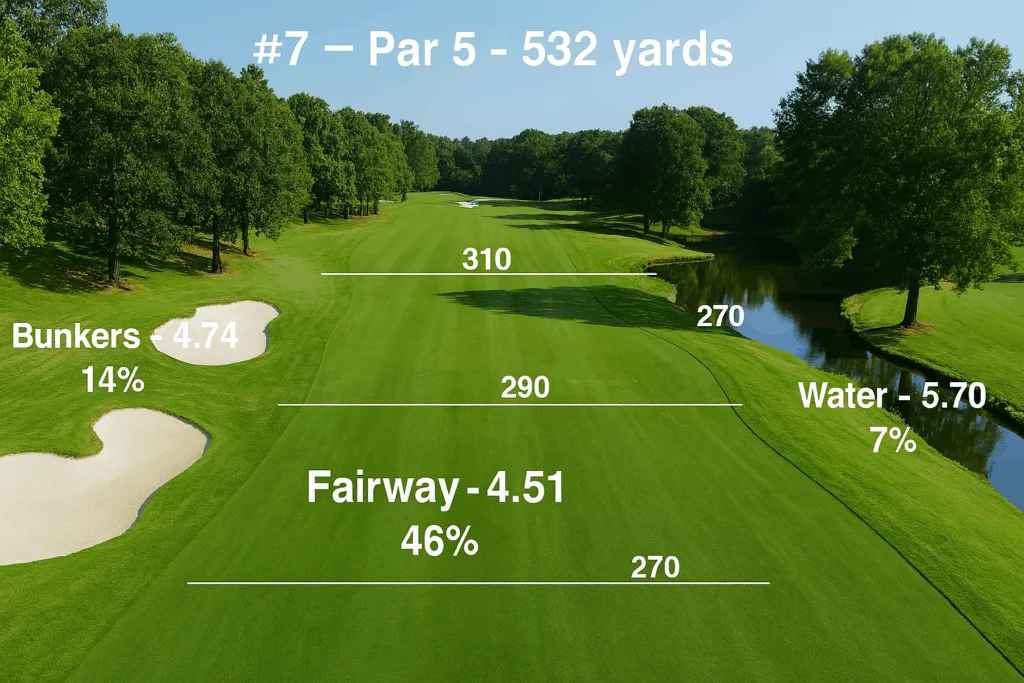
Strokes Gained: Golf’s Answer to xG
Strokes Gained (SG) is a relative measure of performance. Instead of simply counting putts or fairways, it asks:
“If every other player had faced my exact shot, how many strokes would they have taken – and did I beat or trail that mark?”
For every distance and lie on the course, millions of data points tell us the field’s average strokes to finish (e.g. 150 yards from the fairway ≈ 2.80). Your actual outcome is compared with that expectation and expressed as a positive (gained) or negative (lost) fraction of a stroke. Add the gains and losses across the round and you get SG: Total; tag the start of each shot and you also get the four component skills:
- Off-the-Tee
- Approach
- Around-the-Green
- Putting
The xG Analogy: Why Football’s Favourite Stat Makes Sense on the Fairway
Football fans now swear by expected goals (xG). xG evaluates every shot by asking how often it is converted on average – distance to goal, angle, defensive pressure and so on – then measures how far a team or player ran above or below that expectation.
Strokes Gained works exactly the same way:
| Football | Golf |
|---|---|
| Shot quality → xG value | Lie & distance → “strokes to finish” |
| Actual goals – xG = over/under-performance | Actual strokes – baseline = strokes gained |
| Sum over match / season | Sum over round / season |
Both stats strip away contextual noise (weather, course set-up, opponent strength) and reveal the underlying skill signal. That makes SG as indispensable to modern golf analysis as xG is to Premier League scouting reports.
How Strokes Gained is Calculated
- Baseline – ShotLink’s historical data gives a strokes-to-finish average for every location/lie combination.
- Compare – Subtract the baseline for the starting position from the baseline at the finishing position (plus one for the shot itself).
- Sum – Add every shot’s gain/loss:
SG for a shot = Baseline(start) – [1 + Baseline(finish)]Example: 150 yds fairway (2.80) → 15 ft putt (1.90):
2.80 – [1 + 1.90] = +0.90 (almost a full stroke gained)Reading the Live Strokes Gained Feed During a Tournament
Because SG Total = score – field average, ranking players by SG is mathematically identical to ranking them by score. The feed simply shows the leaderboard before the official board has updated.
- Every +1 SG per round moves a player ~12–13 places up the leaderboard.
- +3 SG/rd wins more than half of full-field PGA Tour events.
- +2 SG/rd produces a top-10 roughly once every eight starts.
Watching SG live lets you separate real moves from noise:
- A player at –4 but losing strokes tee-to-green is riding a hot putter – likely unsustainable.
- A player at –1 but gaining 2+ strokes ball-striking is primed to surge if the putter warms up.
Variability, Putting Volatility and Predictive Power
SG’s great party trick is showing how repeatable each skill is:
| Component | Year-to-year correlation | Why it matters |
|---|---|---|
| Approach | ≈ 0.55 | Stable skill → best single predictor of long-term success |
| Off-the-Tee | ≈ 0.50 | Driving distance & accuracy largely repeat |
| Putting | ≈ 0.25 | Highly volatile; form swings week-to-week |
| Around-the-Green | ≈ 0.15 | Small sample per round + lie variability |
Put another way, ball-striking carries the signal, putting carries the noise. A player can gain +6 strokes with the putterin one round – and give it straight back the next day. Bettors who chase yesterday’s hot flat-stick often pay tomorrow’s price.
Practical Benchmarks: How Many Strokes Do You Need to Contend?
| SG per round | Four-round total | Typical finish |
|---|---|---|
| 0 | 0 | ~51st (makes cut, mid-pack) |
| +1 | +4 | ~39th |
| +2 | +8 | ~26th |
| +3 | +12 | ~14th / realistic chance |
| +4 | +16 | Top-3 / usually enough to win |
Major venues nudge these targets up by ~0.2–0.3 SG/rd because the field is stronger.
Key Take-aways for Bettors, Viewers and Golfers
- Treat SG like xG: it’s the clearest performance-above-context lens available.
- Follow the right line: Focus on SG: Approach and SG: Off-the-Tee for predictive edges; beware of chasing transient putting spikes.
- Use live SG to anticipate moves: The numbers reveal who’s trending before the scoreboard catches up.
- Benchmark sensibly: +2 SG/rd is top-25 golf; +3 SG/rd is winning golf.
Final Thoughts
Strokes Gained does for golf what xG did for football: it turns raw outcomes into actionable insight. Whether you’re coaching, trading, or just watching with a pint in hand, understanding where strokes are gained (or lost) brings the sport – and its betting markets – into far sharper focus.
